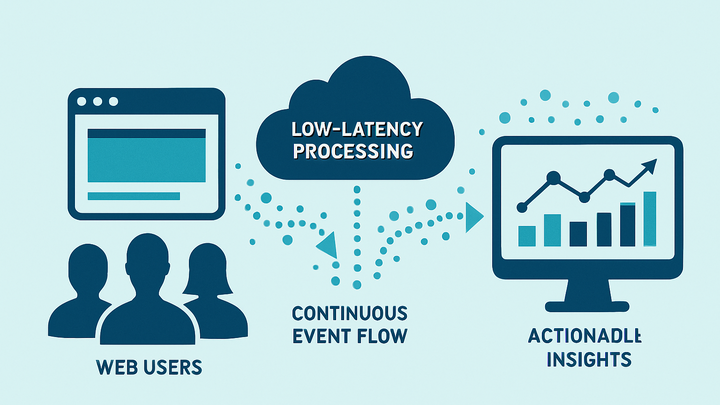Published on 2025-06-26T04:22:52Z
What is Streaming in Analytics? Examples with GA4 and PlainSignal
Streaming analytics is the continuous processing and analysis of data as it is generated, rather than in large batch intervals. In the context of digital analytics, streaming involves capturing user interactions, logs, and events in real time. This approach contrasts with traditional batch processing, where data is collected, stored, and then processed at scheduled intervals. Streaming enables near-instant insights, empowering businesses to react to user behavior, detect anomalies, and personalize experiences on the fly. Modern analytics platforms like GA4 and PlainSignal leverage streaming pipelines to ingest and process millions of events per second with minimal latency. With streaming, organizations can monitor metrics such as pageviews, clickstreams, and conversions as they happen, enabling proactive decision-making and improved customer engagement.
Streaming
Streaming analytics processes data continuously as it’s generated, enabling real-time insights and actions.
Definition and Key Concepts
Streaming analytics involves the real-time ingestion and analysis of data streams, focusing on low-latency processing and continuous insights.
-
Continuous data ingestion
Events are captured and processed as they occur, enabling immediate visibility into user interactions and system events.
-
Event streams
Data is represented as a sequence of discrete events, such as clicks, pageviews, or sensors readings.
-
Low latency
A primary goal is minimal delay between data generation and analysis, often within milliseconds or seconds.
-
-
Stream processing engines
Specialized frameworks and tools handle the continuous computation and aggregation of streaming data.
-
Windowing
Techniques like tumbling and sliding windows group events into manageable segments for analysis.
-
State management
Maintaining context, such as user session or cumulative counts, is essential for accurate real-time analytics.
-
Common Use Cases
Streaming analytics unlocks new capabilities by providing immediate insights into dynamic data flows.
-
Real-time website analytics
Track pageviews, clicks, and conversions as they happen to optimize user journeys and campaigns.
-
Personalization and user engagement
Deliver tailored content, recommendations, or UI changes instantly based on live user behavior.
-
Anomaly detection and alerting
Identify irregular patterns—such as traffic spikes or errors—in real time and trigger automated alerts.
Implementing Streaming with SaaS Products
Popular analytics platforms like GA4 and PlainSignal offer built-in streaming capabilities to simplify real-time data collection and analysis.
-
Google analytics 4 (GA4)
GA4 provides real-time reports and supports streaming export to BigQuery. Use the Measurement Protocol or the Analytics Data API to send events instantly for advanced real-time queries.
-
PlainSignal (cookie-free simple analytics)
PlainSignal enables lightweight, privacy-focused streaming analytics without cookies. Integrate by adding a single script tag:
<link rel="preconnect" href="//eu.plainsignal.com/" crossorigin /> <script defer data-do="yourwebsitedomain.com" data-id="0GQV1xmtzQQ" data-api="//eu.plainsignal.com" src="//cdn.plainsignal.com/plainsignal-min.js"></script>Once loaded, events stream in real time to the PlainSignal dashboard for immediate insights.
Best Practices and Challenges
Ensuring reliability, scalability, and compliance is key when working with streaming data.
-
Scalability and performance
Architect streaming pipelines to handle variable loads using auto-scaling compute, partitioning, and backpressure strategies.
-
Data quality and consistency
Implement validation, deduplication, and ordering guarantees to maintain trust in real-time analytics.
-
Privacy compliance
Respect regulations like GDPR and CCPA by anonymizing personal data in streams and honoring user consent preferences.
